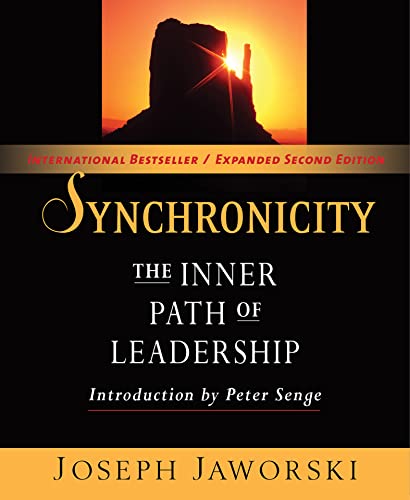Has it ever happened to you that when you finally took the first steps toward realizing something you have been dreading or probably procrastinating things mysteriously start to fall in order for you and new opportunities and ideas start springing from nowhere as if a hidden hand is helping you? Welcome to the world of synchronicity.
Synchronicity: The Inner Path to Leadership is a book by Joseph Jaworski which covers at length the concept of synchronicity in its relation with leadership. When I first came to Jaworski’s book, I was in a period of my life when I was desperately searching for meanings to understand the concepts of consciousness, spirituality, and the after life.
Since mom lost consciousness almost three years ago due to a brain injury and my quest for such understanding intensified. During my sleepless nights with her, I would hold her frail hands and look at her lifeless body and start pondering questions related to the nature and essence of consciousness. I wanted to know where people go once they lose their consciousness.
Do they go to the same place as dead people or are they in a different place? Are they with us, in our world, knowing everything we do but simply are unable to communicate with us? Are they trapped in their bodies? Do they feel pain and happiness? These and several questions were constantly nagging me seeking an answer. The concept of synchronicity probably can’t answer all my questions but it does help illuminate parts, tiny as they are, of that somber world.
That being said, I was disappointed after reading Jaworski’s book and realizing that he did not accord the concept of consciousness much thought. Jaowrski’s focus in his discussion of synchronicity is leadership. That should be evident to me from the subtitle of the book. However, I do not regret reading the book and I actually learned a great deal from it.
The main argument of Synchronicity: The Inner Path to Leadership is that when you work on yourself, develop a growth mindset, and embrace hardships, fate comes your way and you enlist the help of synchronicity. In some sort, you become the creator of your own circumstances.”If we have truly committed to follow our dream,” Jaworski declared, ” we will find that a powerful force exists beyond ourselves and our conscious will, a force that helps us along the way, nurturing our quest and transformation”.
Jaworki’ s quest to investigate synchronicity was born out of a series of personal circumstances that resulted in inner transformations for him. As he himself stated:
“My quest to understand synchronicity arose out of a series of events in my life that led me into a process of inner transformation. As a result of this transformation I decided to follow a dream that I had held close to my heart for a number of years. It was the most difficult decision I had ever made, but the day I made it, I crossed a threshold. From that moment on, what happened to me had the most mysterious quality about it.
Things began falling into place almost effortlessly, and I began to discover remarkable people who were to provide crucial assistance to me. This lasted for over a year. Then I lost the flow and almost destroyed the dream I had worked so hard to establish. Ultimately I regained the capacity to participate in what I later came to understand as an unfolding creative order.”
What is synchronicity?
Synchronocity is a concept created and popularized by the Swiss psychiatrist Carl Gustav Yung (1875-1961). In his book “Synchronicity: An Acausal Connecting Principle,” Yung defines synchronicity as “a meaningful coincidence of two or more events, where something other than the probability of chance is involved.” (quoted in Jaworski’ s).
For Jaworski, synchronicity is a state of high flow and high energy. He counted a number of personal incidents and meetings with people in which the power of synchronicity was clearly evidenced. One of them, for instance, is what happened to him with his son in the O’Hare Airport in the United States.
Related: Best Books on Synchronicity
As Jaworski and his kid were rushing to catch their plane, his eyes met the eyes of a woman walking by. He thought for a moment that he knew her from somewhere and as she walked away, he stood ‘dumbstruck’ looking at her direction. After contemplating the whole scene, Jaworski decided to run after her and stop her just before she boarded her plane to Dallas. He asked for her phone number and promised to call her. Little did he know that Mavis was to become his wife and life companion.
Leadership for Jaowrski is “about creating a domain in which we continually learn and become more capable of participating in our unfolding future”. He further added that “a true leader thus sets the stage on which predictable miracles, synchronistic in nature, can—and do—occur.”
Jaworski concludes the book with an important lesson about leadership: which is that leadership is “more about being than doing. It is about our orientation of character, our state of inner activity”.
Quotes that stood out to me from Jaworski’s book:
“If we have truly committed to follow our dream, we will find that a powerful force exists beyond ourselves and our conscious will, a force that helps us along the way, nurturing our quest and transformation.”
“The world we have created is a product of our way of thinking” Einstein quoted in Jaworski.
“Because of how we think, we’re strangling the life out of ourselves. When we start to see the world more as it is, we stop strangling ourselves.”
“The world is not fixed but is in constant flux; accordingly, the future is not fixed, and so can be shaped. Humans possess significant tacit knowledge—we know more than we can say. The question to be resolved: how to remove the blocks and tap into that knowledge in order to create the kind of future we all want?”
“Our mental model of the way the world works must shift from images of a clockwork, machinelike universe that is fixed and determined, to the model of a universe that is open, dynamic, interconnected, and full of living qualities.”
Final thoughts
Wrapping things up, “Synchronicity: The Inner Path to Leadership” by Joseph Jaworski gave me much to ponder, even if it didn’t directly address my deep-rooted questions about consciousness and the essence of being. What struck me was its emphasis on how personal growth and embracing challenges could evoke the force of synchronicity, steering us toward ‘predictable miracles,’ as Jaworski puts it.
While I felt a twinge of disappointment that the book didn’t delve into the concept of consciousness as much as I’d hoped, the nuggets of wisdom about leadership and character development are noteworthy. Jaworski made it clear that leadership is not just about doing; it’s about being. It’s about the internal state that paves the way for an unfolding creative future. And although the concept of synchronicity might not answer all my existential questions, it offers a compelling framework for understanding how the universe might conspire in our favor when we commit to our personal growth and leadership paths. So, if you’re ever at a crossroads, looking for some ‘mysterious quality’ to guide you, perhaps diving into the realm of synchronicity isn’t such a bad idea.




